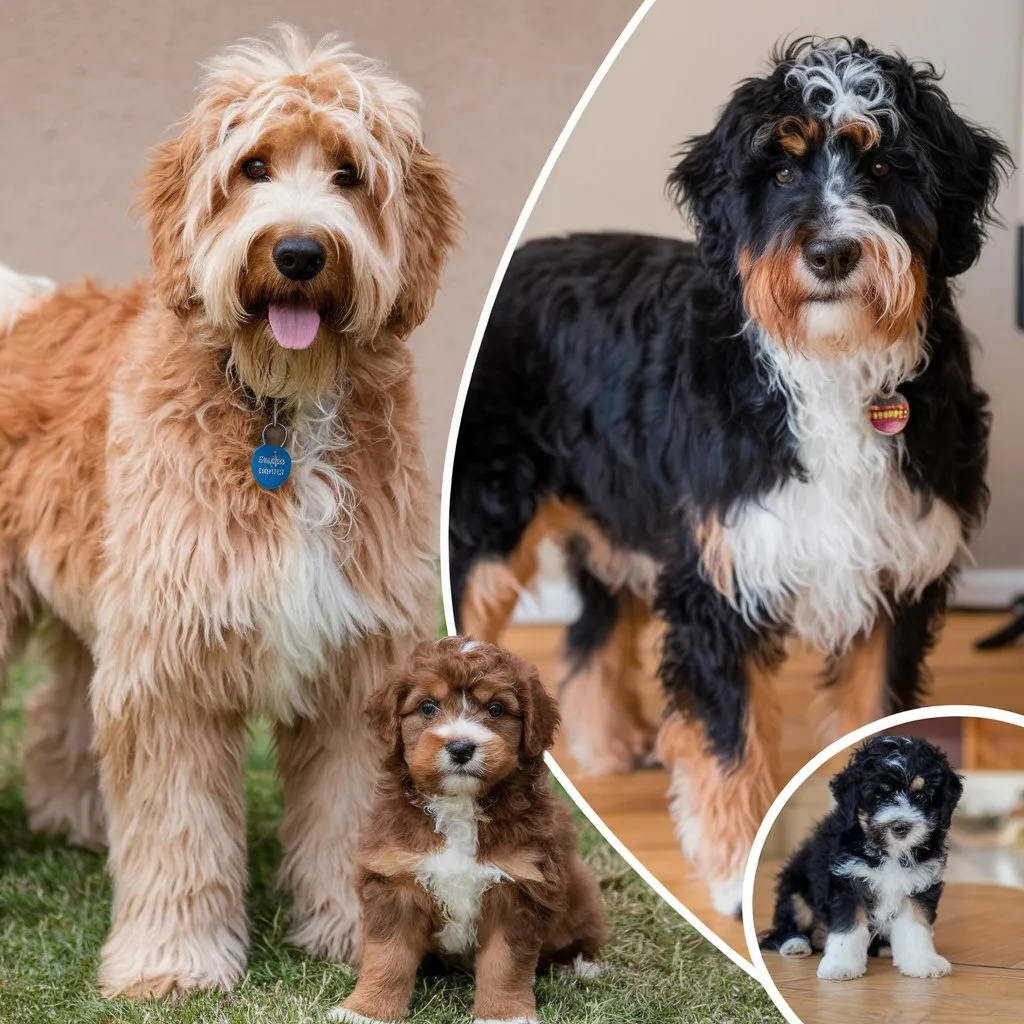Labradoodle Vs Aussiedoodle: Which Doodle Makes the Better Family Pet?
As you weigh the pros and cons of bringing a Labradoodle or Aussiedoodle into your life, you’re likely wondering which breed is the best fit for you. Both hybrids boast incredible intelligence and affectionate nature, but that’s where the similarities end.
You’ll need to ponder factors like energy levels, coat types, and training styles to make an informed decision.
For instance, do you have the time and resources to keep up with an Aussiedoodle’s high energy demands, or would a Labradoodle’s lower-maintenance coat be a better fit?
The choice isn’t an easy one, but understanding these key differences will help you make a decision that’s right for you.
In a Nutshell

- Labradoodles have a moderate energy level, while Aussiedoodles have high energy levels, requiring more exercise and stimulation.
- Both breeds have different coat types, with Labradoodles being curly and non-shedding, and Aussiedoodles being wavy or straight with moderate shedding.
- Aussiedoodles require a more structured and consistent training approach, while Labradoodles thrive in reward-based training.
- Both breeds are highly adaptable to families with varying lifestyles and living situations, but Aussiedoodles need a secure, fenced yard.
Size and Weight Comparison

When comparing the physical characteristics of Labradoodles and Aussiedoodles, one of the most notable differences lies in their size and weight, with Labradoodles typically ranging from 18-24 inches in height and 50-65 pounds in weight, while Aussiedoodles usually stand between 18-22 inches tall and weigh between 30-50 pounds.
As you consider bringing one of these breeds into your life, it’s vital to understand their puppy development stages and growth patterns.
During the first year, both breeds experience rapid growth, with Labradoodles reaching about 70% of their adult size by six months, while Aussiedoodles reach around 60%.
By 12-18 months, they’ve typically reached their full height, with some Labradoodles continuing to fill out until they’re two years old.
Understanding these growth patterns can help you prepare for the space and resources your dog will need as they mature.
Energy Levels and Exercise Needs

When considering bringing a Labradoodle or Aussiedoodle into your family, you’ll need to think about their energy levels and exercise needs.
You’ll want to know if you can provide the daily exercise requirements that will keep them happy and healthy.
Daily Exercise Requirements
You’ll need to dedicate a significant amount of time to exercising your Labradoodle or Aussiedoodle, as both breeds require daily physical and mental stimulation to prevent boredom, destructive behavior, and obesity.
A well-structured daily exercise routine is essential to keep your furry friend happy and healthy.
Incorporating morning routines, such as 30-minute walks or playtime, can help burn off excess energy and set a positive tone for the day.
This can be followed by shorter, more relaxed sessions throughout the day, like short walks or play breaks.
Evening strolls are also an excellent way to wind down and provide mental stimulation.
Aim for at least 60-90 minutes of exercise per day, spread out over 2-3 sessions.
This will help maintain your dog’s physical and mental well-being, while also strengthening your bond and reducing the risk of behavioral issues.
High-Energy Play Needs
Both Labradoodles and Aussiedoodles are high-energy breeds that require intense play sessions to satiate their natural instincts and burn off excess energy.
As their owner, prioritizing playtime routines that cater to their high-energy needs is vital. You’ll need to commit to regular outdoor adventures that challenge them physically and mentally.
Fetch and chase: Engage your dog in a game of fetch, and then suddenly change direction to keep them on their toes.
Hiking and trail running: Take your dog on a hike or trail run to provide a change of scenery and a physical challenge.
Agility training: Set up an obstacle course in your backyard or sign up for agility classes to provide mental stimulation.
Water play: If your dog loves water, take them to a dog-friendly beach or pool for a fun and invigorating play session.
Coat Types and Grooming Requirements

Your Labradoodle or Aussiedoodle‘s coat type will substantially impact their grooming requirements, as some varieties require daily brushing to prevent matting and tangling.
Fur texture differences are significant between these breeds. Labradoodles often inherit the Poodle’s curly, non-shedding coat, which requires regular grooming to prevent matting. Aussiedoodles, on the other hand, might’ve a wavy or straight coat, similar to the Australian Shepherd’s, which sheds moderately.
You’ll need to brush your Aussiedoodle regularly, but not as frequently as a Labradoodle.
Shedding patterns also vary between the breeds. Labradoodles tend to shed very little, making them a great choice for those with allergies.
Aussiedoodles, however, may shed more, especially during seasonal changes. You’ll need to weigh these differences when deciding which breed is right for you.
If you’re willing to commit to regular grooming, a Labradoodle might be the better choice. But if you prefer a lower-maintenance coat, an Aussiedoodle could be the way to go.
Either way, you’ll need to be prepared to invest time and effort into keeping your dog’s coat healthy and looking its best.
Temperament and Trainability

As you consider bringing a Labradoodle or Aussiedoodle into your family, you’re likely wondering about their temperament and trainability.
You’ll want to know how their energy levels compare and how their training styles differ.
In this section, you’ll discover the key differences between these two breeds, helping you determine which one is the best fit for you.
Energy Levels Compared
Labradoodles and Aussiedoodles exhibit distinct energy levels, which markedly impact their temperament and trainability. As you consider bringing one of these breeds into your life, it’s vital to comprehend their energy needs to guarantee you can provide the necessary environment for them to flourish.
Labradoodles tend to have moderate energy levels, requiring daily walks and playtime, but they’re also happy to adapt to a more relaxed lifestyle. Aussiedoodles, on the other hand, have high energy levels and need more intense exercise and mental stimulation to prevent boredom and destructive behavior.
Labradoodles enjoy leisure activities like swimming, hiking, and playing fetch, but they’re not as demanding as Aussiedoodles, who require more challenging activities like agility training, running, or herding.
Labradoodles need at least 30 minutes of exercise per day, while Aussiedoodles require a minimum of 60 minutes of intense physical activity.
Both breeds need mental stimulation, but Aussiedoodles require more complex and engaging activities to prevent boredom and stress.
Understanding these energy level differences will help you determine which breed is best suited to your lifestyle and living situation.
Training Style Differences
When it comes to training, Labradoodles and Aussiedoodles respond best to different approaches, largely due to their distinct temperaments and levels of trainability.
As you consider bringing one of these breeds into your life, understanding their unique needs is vital.
Labradoodles, with their friendly and outgoing nature, thrive in reward-based training environments that focus on positive reinforcement. They’re highly social and enthusiastic to please, making them quick learners when motivated by treats and praise.
Aussiedoodles, on the other hand, require a more structured and consistent approach. Their high energy levels and strong herding instincts mean they need clear boundaries and a firm but gentle hand.
Positive reinforcement is still key, but you’ll need to be more intentional about setting goals and providing clear rewards. By adapting your training style to your dog’s unique temperament, you’ll set them up for success and build a strong, loving bond.
Health Concerns and Lifespan

Your Labradoodle or Aussiedoodle’s genetic makeup can predispose them to certain health issues, including hip dysplasia, progressive retinal atrophy, and Addison’s disease.
As a responsible owner, you must comprehend the genetic predispositions that can lead to inherited disorders in your pet.
Hip Dysplasia: A genetic condition that can lead to arthritis and mobility issues.
Progressive Retinal Atrophy: A degenerative eye disorder that can cause blindness.
Addison’s Disease: A hormonal disorder that affects the adrenal glands.
Allergies: Both Labradoodles and Aussiedoodles can inherit allergies from their parent breeds.
On average, Labradoodles can live between 12-14 years, while Aussiedoodles can live between 12-15 years.
Regular check-ups, a balanced diet, and plenty of exercise can help mitigate these health concerns and guarantee your pet lives a long, healthy life.
Family Suitability and Adaptability

Both Labradoodles and Aussiedoodles are highly adaptable breeds that thrive in families with varying lifestyles and living situations, making them an excellent choice for many households. When contemplating bringing one of these breeds into your family, it’s crucial to examine your family dynamics and parenting styles.
| Family Aspect | Labradoodle | Aussiedoodle |
|---|---|---|
| Energy Level | Suitable for families with high energy levels, as they require regular exercise | Thrive in families with moderate to high energy levels, needing daily physical and mental stimulation |
| Space Requirements | Can adapt to apartments or homes with small yards, but require regular outdoor activities | Need a secure, fenced yard for exercise and play, but can adapt to apartment living with regular outdoor activities |
| Noise Tolerance | Tolerant of noise and commotion, making them suitable for families with multiple children | Sensitive to loud noises, requiring a calm and peaceful environment |
| Socialization Needs | Require early socialization to thrive in families with multiple children and pets | Need early socialization to adapt to new people, pets, and environments |
Ultimately, both breeds are excellent choices for families who are willing to provide the necessary care, attention, and exercise. By understanding your family’s unique dynamics and needs, you can determine which breed is the best fit for you.
Cost and Maintenance Differences

Calculating the costs and maintenance requirements of Labradoodles and Aussiedoodles is essential to guarantee you’re prepared for the financial and time commitments involved in caring for these breeds.
As you ponder bringing one of these dogs into your life, it’s vital to factor in the expenses that come with their care.
Initial Purchase Price: Labradoodles tend to be more expensive than Aussiedoodles, with prices ranging from $1,500 to $5,000 compared to $1,000 to $3,000 for Aussiedoodles.
Grooming Needs: Both breeds require regular grooming, but Labradoodles may need more frequent trimming and clipping, adding to their overall maintenance cost.
Pet Insurance: Aussiedoodles are generally considered healthier than Labradoodles, which may lead to lower pet insurance premiums.
Veterinary Bills: Labradoodles are more prone to certain health issues, such as hip dysplasia, which can result in higher veterinary bills over time.
Frequently Asked Questions
Are Labradoodles and Aussiedoodles Good With Small Pets Like Hamsters?
You’ll find that, with proper socialization techniques and gentle introductions, many breeds can thrive alongside small pets like hamsters; however, it’s vital to research and understand the individual temperaments and needs of both your dog and pet.
Can These Dogs Thrive in Apartments With Limited Outdoor Space?
You can thrive in an apartment with limited outdoor space by providing compact exercises, like indoor fetch and stair climbing, perfect for urban dwellers seeking freedom, as long as you commit to regular, creative activity.
Do Labradoodles and Aussiedoodles Make Good Service Dogs?
You’ll find that many breeds can make excellent service dogs, but it’s vital to weigh training requirements and temperament evaluation. Both labradoodles and aussiedoodles possess traits that make them suitable, but individual assessments are key to determining their service dog potential.
Are They Prone to Destructive Behavior if Left Alone Too Long?
When you leave your dog alone for too long, they might develop separation anxiety, which can lead to destructive behavior. Boredom triggers this anxiety, so engaging their minds and exercising them regularly can prevent it.
Can These Breeds Be Left Outside in Extreme Weather Conditions?
You need to ponder your dog’s winter hardiness and climate tolerance before leaving them outside in extreme weather. Generally, dogs can adapt to outdoor conditions, but prolonged exposure can be harmful, so provide adequate shelter and monitoring.










Hi, I’m Ella Frost, a devoted animal lover working at CuddlyCreatureCare.com. My passion for animals drives me to share my knowledge through comprehensive guides on animal care and rescue. I’m here to help you understand and care for your furry friends better.







